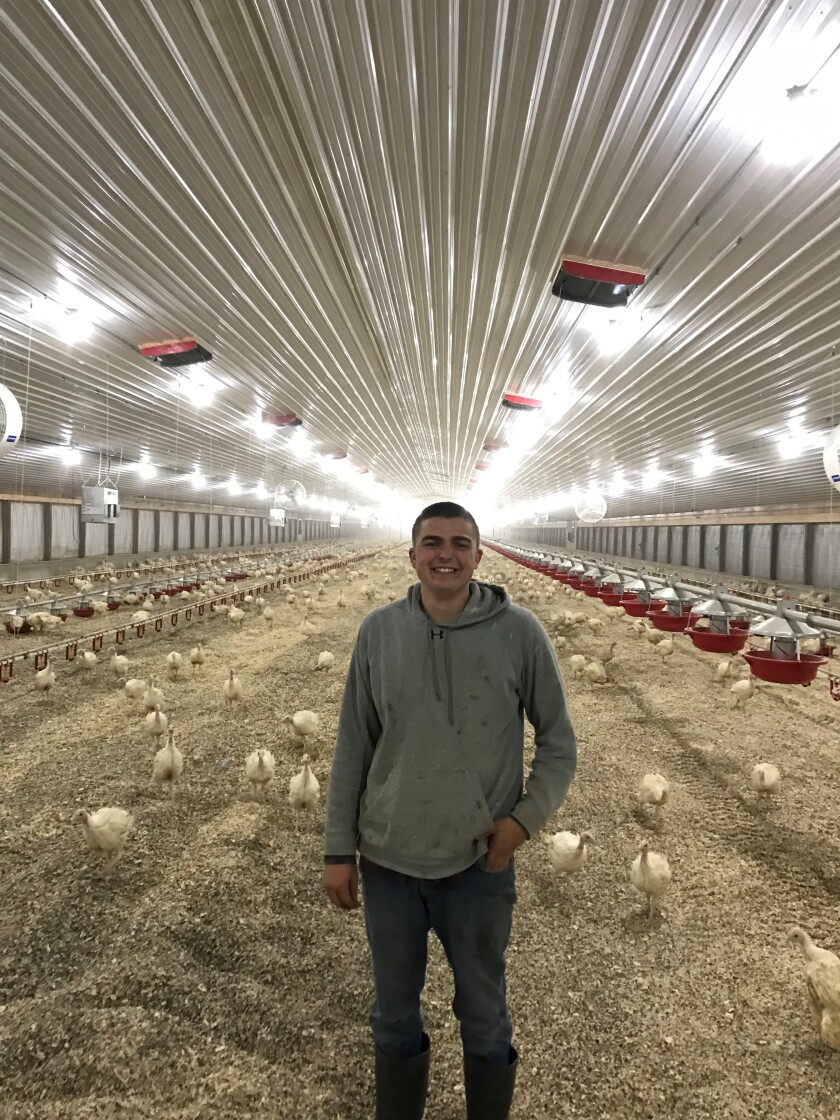Imagine almost 5,000 elementary students entering a barn filled with 40,000 turkeys. It’s not something that happens these days with important biosecurity measures in place. The technological advances of a virtual field trip provided by Minnesota Agriculture in the Classroom make it possible.
That’s what happened just two days before Thanksgiving, Nov. 26, on a now, but was seen live by about 230 Minnesota classrooms during a half-hour tour. The trip was targeted toward kindergarten through fifth-grade students and brought in classrooms from all corners of the state. It was a near-record crowd for the tour, according to Sue Knott, Minnesota Ag in the Classroom education specialist.
ADVERTISEMENT
The first virtual field trip hosted by MN Ag in the Classroom was in 2016. Since then, they have hosted about 37. Many are linked on their and are featured on the .
On this particular tour, all eyes were on Hunter Kvistad, owner of Kvistad Turkey Farm, near Wood Lake, Minnesota, as he was sweating away inside his brooder barn. While it was 17 degrees outside, it was a roasting 100 degrees inside — just how the turkeys like it. The turkeys start out at 103 degrees, and the temperature drops about 1 degree per day until it reaches 74 degrees. That’s where they’ll stay until it’s time to ship them out at about 12 weeks old.
Kvistad paced inside a bright and clean poultry barn with young poults on either side of him. This was the second time Kvistad had welcomed students on a virtual tour inside his barns. The classrooms sent in question after question.
What kind of turkeys are these?
Kvistad explained that these are white, meat birds, not like the wild turkeys seen in the woods and fields or wandering the neighborhood.
“So these are the type of turkeys that will be on your Thanksgiving table,” he said.
In fact, Kvistad’s turkeys go to Jennie-O in Melrose, Minnesota, at about 16 pounds. He explained to students that they can look at the label on their Jennie-O turkey and find out the farm where the turkey came from. It’s always a joy to hear from someone who got a turkey from his farm, he said.

Kvistad also pointed out that all the turkeys in his barns are hens.
ADVERTISEMENT
“In my opinion, they’re nicer,” he said of the hens compared to the toms.
Kvistad’s family has been raising them since 1972. He’s a third-generation turkey farmer. His dad and grandpa live nearby and are able to step in and help as needed.
What’s in the feed?
Kvistad explained it’s a formula of crushed corn, soybeans, vitamins and minerals essential to the turkey’s diet. The food comes from huge bins outside the barn and makes its way to the pens automatically so the turkeys have access to food whenever they want it.
Kvistad explained further that it takes about 2 pounds of feed to make 1 pound of turkey. His full flock might eat about a million pounds of feed and weigh in at nearly half a million pounds.
What’s in the bedding?
The poults were walking on a fresh bed of wood shavings and sunflower hulls harvested in South Dakota and distributed from Melrose, Minnesota, Kvistad said.
“So we use sunflower hulls for dust control — that helps with their respiratory system,” he said. The oil in sunflower hulls acts to hold down the dust.
When does a turkey sleep?
“They’re little babies, they sleep all of the time,” Kvistad said. “Wherever their hearts desire.”
ADVERTISEMENT
Kvistad showed how some of the turkeys were sleeping as many others were busy eating and moving around the pens.
What precautions must a turkey farmer take?
Kvistad showed how he walks into the barn in one pair of boots and switches to another pair of boots he uses in the barn only. Before entering the turkey pen, he steps in a disinfectant and uses hand sanitizer on his hands. He comes in with clean clothes each time he enters.
“You never know what you got on you. Bacteria is really small, and I can’t see it,” he said.
Kvistad cares for turkeys 365 days a year as his full-time job.
How much does it pay?
Kvistad couldn’t say how much the turkeys cost or what they sold for, but he was paid to grow them using an equation based on feed and fuel costs.
“So it varies drastically based on the corn market, propane … it’s drastic the changes in price,” he said.
ADVERTISEMENT
What is your favorite thing about being a turkey farmer?
“The satisfaction that this job gives me is unbelievable,” Kvistad said. He raises 240,000 turkeys a year. “And I am feeding so many people. I love feeding people.”
Kvistad, like other turkey farmers in the state, is proud to continue to be part of the process that makes Minnesota the No. 1 producer of turkeys in the country. Minnesota produces about 39 million turkeys a year. He said what many people don’t know is that most turkeys are raised by family farmers just like him.











